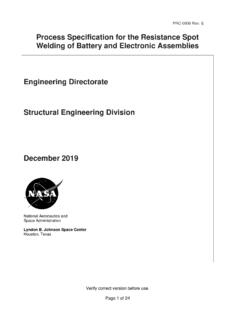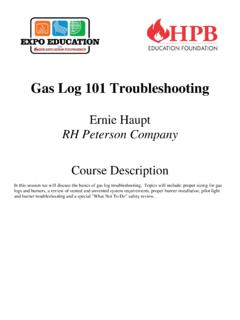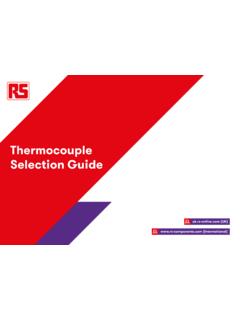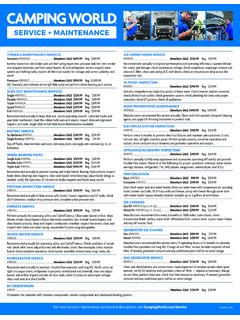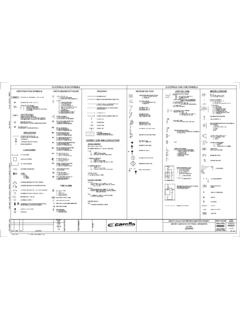Transcription of Military Standard Preparation for and Installation of ...
1 INCH-POUND MIL-STD-403C 30 June 1992 I SUPERSEDING MIL-STD-403B 14 June 1968 Military Standard Preparation FOR AND Installation OF RIVETS AND SCREWS, ROCKET, ~ _.:? .. l '\: MISSILE, AND AIRFRAME STRUCTURES AMSC N/A FSC 1410 DISTRIBUTION STATEMENT A. Approved for public release; distribution is unlimited . I MIL-STD-403C FOREWORD 1. This Military Standard is approved for use by all Departments and Agencies of the Department of Defense. 2. Beneficial comments (recommendations, additions, deletions) and any pertinent data which may be of use in improving this document should be addressed to: Commander, Army Missile Command, ATTN: AMSMI-RD-SE-TD-ST, Redstone Arsenal, AL 35898-5276 by using the Standardization Document Improvement Proposal (DD Form 1426) appearing at the end of this document or by letter. ii MIL-STD-403C.
2 \ Paragraph 1. 1. 1 2. 2 . 3. 4 . 4 .1. 1 5. 5 . CONTENTS SCOPE 1 Purpose 1 APPLICABLE DOCUMENTS 2 Government documents 2 Specifications, standards , and handbooks 2 Order of precedence 2 DEFINITIONS 4 Definitions 4 Cocked head 4 Manufactured head 4 Upset head (shop formed) 4 Dimpling 4 Draw dimpling 4 Modified-radius dimpling 4 Countersinking (machine countersinking) 4 GENERAL REQUIREMENTS 5 Hole formation 5 Hole sizes 5 Dimpling 5 Modified-radius dimpling 5 Cracked dimples 5 Countersinking 5 Combination dimple and countersinking for rivets and screws 5 Cleaning and protective coatings 6 Finishing sequence 6 Sealing 6 Cleaning of mating surfaces 6 Removal of strippable coating 6 Materials which are to be stored after drilling 6 Gap limitations between joined sheets 6 DETAILED REQUIREMENTS 7 Dimpled holes 7 Dimpling 7 Dimpling temperatures 7 Hot dimpling precaution 7 iii MIL-STD-403C Paragraph 6.
3 Table (s) I II III IV CONTENTS Rivets Conventional rivets Pull-through and self-plugg~ng blind rivets Acceptable and unacceptable limits of upset heads shall be as shown in Figure 4 Chemically expanded rivets Rivet hole tolerance Countersinking Combination dimple and countersinking Rivet heads Manufactured rivet head height Cocked heads Upset heads Malformed upset heads Cracked upset heads Marring of the head Head gap Rivet lengths Screws Hole screws Oversize holes Countersinking Combination dimple and countersinking Skin damage NOTES Intended use Issue of DODISS Metrication Subject term (key word) listing Changes from previous issue TABLES Holes for conventional rivets Holes for pull-through self-plugging rivets Holes for chemically expanded rivets Holes for screws iv Page 8 8 8 '8 8 ._B 9 9 9 9 9 9 9 9 10 10 10 10 10 10 10 10 10 11 11 11 11 11 11 12 13 14 15 MIL-STD-403C Table(s) v VI VII Figure(s) i 2 3 4 5 6 7 8 CONTENTS For 2017-T rivets driven hard 16 For all rivets except 2017-T rivets driven hard 17 Average nominal projection before driving 18 Dimple size dimensions for rivets 19 Countersink dimensions for rivets 20 Combination dimple and countersink dimensions for rivets 21 Acceptable and unacceptable conditions 22 Upset head diameter 23 Dimple dimensions for screws 24 Countersink dimensions for screws 25 Combination dimple and countersink dimensions for screws 26 v MIL-STD-403C 1.
4 SCOPE Purpose. The purpose of this Standard is to establish acceptable limitations applicable to Preparation for, and Installation of rivets and screws for rocket, missile and airframe structures . 1 MIL-STD-403C 2. APPLICABLE DOCUMENTS Government documents. Specifications, standards , and handbooks. The following specifications, standards , and handbooks form a part of this document to the extent specified herein. Unless otherwise specified, the issues of these documents are those listed in the issue of the Department of Defense Index of Specifications and standards (DODISS) and supplement thereto, cited in the solicitation (see ) SPECIFICATION Military MIL-P-116 Preservation, Methods of MIL-S-8802 Sealing Compound, Temperature Resistant, Integral Fuel Tanks and Fuel Cell Cavities, High Adhesion MIL-S-11030 Sealing Compound, Single Component, Non-Curing, Poiysulfide Base SPECIFICATION FEDERAL TT-P-1757 Primer Coating, Zinc Chromate, Low Moisture Sensitivity Standard Military MIL-STD-171 Finishing of Metal and Wood Surfaces (Unless otherwise indicated, copies of the federal and Military specifications, standards , and handbooks are available from the Standardization Documents Order Desk, Bldg.)
5 4D, 700 Robbins Ave., Philadelphia, PA 19111-5094.) Order of precedence. In the event of a conflict between the text of this document and the references cited herein, the text of this document takes precedence. Nothing in this document, 2 MIL-STD-403C however, supersedes applicable laws and regulations unless a specific exemption has been obtained. 3 MIL-STD-403C 3. DEFINITIONS Definitions. For the purposes of this Standard , the following definitions shall apply. Cocked head. The seating of either the manufactured head or the upset head at an angle other than perpendicular to the shank of the rivet parallel to the surface. Manufactured head. The head formed at the time the rivet is manufactured. Upset head (shop formed). The head formed during the riveting operation. Dimpling. Stretching a relatively small shallow indentation into sheet metal.
6 Stretching metal into a conical flange for use of a countersunk rivet or screw. Dimpling is substantially stronger than countersinking and should be performed on relatively thin panels. Draw dimpling. Dimpling that is produced by utilizing a male and female die without first preparing a pilot hole. The dimple dies punch the hole and form the dimple in a single operation. (NOTE -Draw dimpling shall not be permitted without written approval of the procuring activity.) Modified-radius dimpling. Dimpling which is produced by utilizing a male and female die where the contour of the dies results in a dimple with the top and bottom sides of the dimple non-parallel. Countersinking (machine countersinking). Chamfering a conical depression around the top of a hole for receiving the head of a fastener. 4 MIL-STD-403C 4. GENERAL REQUIREMENTS Hole formation.
7 I, II, III, or Hole sizes. Unless otherwise specified, pilot holes shall be drilled before dimpling. The final hole size shall be drilled or reamed after dimpling, or countersinking. Hole tolerance shall be in accordance with tables I, II, III, or IV. Dimpling. Where flush applications of rivets and screws are specified, both sheets to be joined shall be dimpled when each sheet is within the thickness specified in tables iv. All parts shall be dimpled separately exceptions: a. Parts cemented together with a total thickness not greater than the greatest thickness for dimpling. b. Parts, spot or seam welded, with a total thickness greater than the greatest thickness for dimpling. Modified-radius dimpling. Modified-radius dimpling shall be used when dimpling by form countersinking is not possible with the following exceptions: a. A modified-radius dimple shall not nest into another modified-radius dimple.
8 B. The greatest material thickness for modified-radius dimpling shall be inch. c. The greatest size of modified-radius dimple shall be inch diameter rivet. Cracked dimples. Cracked dimples shall be rejected. Any r pairs shall be subject to engineering approval. Countersinking. Countersinking shall be used when the outer sheet is within the limits specified in tables I, II, III, or IV, or when dimpling is not permitted by engineering drawings or by this Standard . Combination dimple and countersinking for rivets and screws. This method shall be used only when specified on the engineering drawings or when the outer sheet is less than the least 5 MIL-STD-403C thickness for countersinking and the inner sheet is greater than the greatest thickness for dimpling. Cleaning and protective coatings. Finishing sequence. Parts shall be cleaned (see ), surface treated or electroplated, and primed in detail prior to assembly as specified on applicable drawings.
9 Sealing. Rivets, buck bolts, blind rivets and threaded fasteners shall be assembled with wet, unthinned zinc chromate primer conforming to TT-P-1757. If the fasteners are dissimilar to and can result in a direct contact with magnesium, a washer of 5052 aluminum alloy with not less than an over-lap of to inch shall be used in addition to TT-P-1757 primer. Other sealing compounds, such as materials conforming to MIL-S 11030 and MIL-S-8802, may be used as substitute for TT-P-1757 when approved by the procuring activity. Cleaning of mating surfaces. All chips, burrs, and foreign material shall be removed from the mating surfaces prior to surface treating. Removal of strippable coating. The temporary strippable coatings must be removed from all joints and from under the heads of all fasteners before installations. Materials to be stored.
10 Materials which are to be stored after drilling, countersinking, or dimpling prior to finishing shall be protected against corrosion in accordance with the applicable methods of MIL-P-116. In cases where drilling, countersinking, or dimpling is accomplished after finishing, the damaged areas of the protective finish shall be repaired with a suitable surface treatment meeting the requirements of MIL-STD-171 and reprimed. Gap limitations between joined sheets. Gap limitations between joined sheets shall be in accordance with figures 1 and 6 and tables I, II, III and IV. 6 MIL-STD-403C 5. DETAILED REQUIREMENTS Dimpled holes. When dimpling is performed, pilot holes shall be drilled, the material dimpled, then the hole drilled or reamed to the final size noted in tables I, II, III, or IV. Both sheets to be joined shall be dimpled when each sheet is within the thickness limits specified in figures 1 or 6 and tables I, II, III, or IV.




